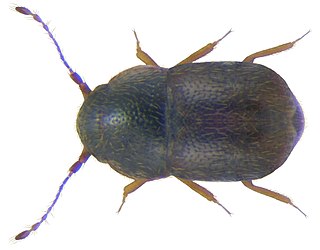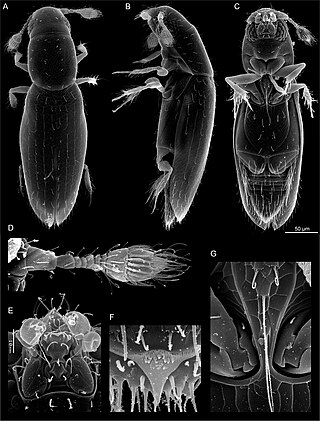
Darkling beetle is the common name for members of the beetle family Tenebrionidae, comprising over 20,000 species in a cosmopolitan distribution.

Staphylinoidea is a superfamily of beetles. It is a very large and diverse group with worldwide distribution.

The family Oedemeridae is a cosmopolitan group of beetles commonly known as false blister beetles, though some recent authors have coined the name pollen-feeding beetles. There are some 100 genera and 1,500 species in the family, mostly associated with rotting wood as larvae, though adults are quite common on flowers. The family was erected by Pierre André Latreille in 1810.

Ptiliidae is a family of very tiny beetles with a cosmopolitan distribution. They are colloquially called featherwing beetles, because the hindwings are narrow and feathery.

Syntelia is a genus of beetles. It is the only genus in the family Synteliidae. There are seven known species, which are native to high-elevation regions in southern North America from central Mexico to Guatemala, and in eastern Asia, from India to Japan and eastern Russia. They are generally associated with rotting logs, typically found under bark, though the Mexican species S. westwoodi has been found inside large decaying columnar cacti. Adults and larvae are predatory, feeding on insect larvae. A fossil species, Syntelia sunwukong, is known from the Late Cretaceous (Cenomanian) aged Burmese amber of Myanmar. Adults are around 1–3.5 centimetres (0.39–1.38 in) in length. The characteristics of the family and genus include geniculate antennae with 3-segmented club, elongate body, narrowly separated coxae and tarsi with bisetose empodia. Only one abdominal segment is exposed behind elytra. The genus described by John O. Westwood in 1864, while the family was erected by George Lewis in 1882. They are members of Histeroidea, which also includes clown beetles (Histeridae).

The minute tree-fungus beetles, family Ciidae, are a sizeable group of beetles which inhabit Polyporales bracket fungi or coarse woody debris. Most numerous in warmer regions, they are nonetheless widespread and a considerable number of species occur as far polewards as Scandinavia for example.

Baeocrara is a genus of featherwing beetles named because of the intricate structure of their flight wings, which have a long fringe of hairs on their borders. They belong to the Ptiliidae family, and are minute: between 1 and 0.5 mm. They are mostly found in hollow fir stumps and other types of rotten wood, dung and plant detritus. They feed on fungal spores. They seem to be recent immigrants to Northern Europe possibly introduced by the import of sawmill products. They have been reported in the Czech Republic. They are one of the least known groups in the Coleoptera.
Stagetus is a genus of death-watch and spider beetles in the family Ptinidae. There are at least 20 described species in Stagetus. They eat fungi.

Jacobsoniidae are a family of tiny beetles belonging to Staphylinoidea. The larvae and adults live under bark, in plant litter, fungi, bat guano and rotten wood. There are around 28 described species in three genera:

Scydosella is a genus of beetles that consists of only one species Scydosella musawasensis. The species is regarded as the smallest free-living insect, as well as the smallest beetle. They are among featherwing beetle, named because of their feather-like spiny wings. It was first discovered in Nicaragua, and described in 1999 by Wesley Eugene Hall of the University of Nebraska State Museum. The initial discovery consisted of very few specimens, and exact measurements were not conclusive. Because of their tiny size, they were difficult to observe under microscope after preservation. The generally accepted size was 0.300 mm in length. On 8 February 2015, Alexey Polilov of the Lomonosov Moscow State University collected 85 specimens in Chicaque National Park, Colombia. They were discovered on a layer of fungus on which they feed. From these specimens exact measurements could be made, and was found that the smallest individual is only 0.325 mm long. The largest individual is 0.352 mm long, and the average length of all the specimens is 0.338 mm. The body is elongated and oval in shape, yellowish-brown in colour, and its antennae are split into 10 segments.
Discheramocephalus brucei is a species of feather-winged beetle, the smallest beetles on earth, first found in Cameroon.
Discheramocephalus elisabethae is a species of feather-winged beetle, the smallest beetles on earth, first found in Cameroon.
Discheramocephalus stewarti is a species of feather-winged beetle, the smallest beetles on earth, first found in Bolivia.
Discheramocephalus jarmilae is a species of feather-winged beetle, the smallest beetles on earth, first found in Bolivia.
Macrocoma splendidula is a species of leaf beetle endemic to the Canary Islands, described by Thomas Vernon Wollaston in 1862.

Macrocoma is a genus of leaf beetles in the subfamily Eumolpinae. It contains about 100 species, which are found in tropical Africa, around the Mediterranean, on the Canary Islands, in western and central Asia, and in India.
Bacanius is a genus of clown beetles in the family Histeridae. There are more than 70 described species in Bacanius.
Sphaericus is a genus of spider beetles in the family Ptinidae. There are more than 30 described species in Sphaericus.
Discheramocephalus is a genus of feather-winged beetles, the smallest beetles on earth, first found in Cameroon. It was originally described in 2007 as a monotypic genus. Six additional species were added in 2008, and two were added in 2013.

Discheramocephalini is a tribe of feather-winged beetles first proposed in 2009. It contains six extant genera, and one extinct genus.











